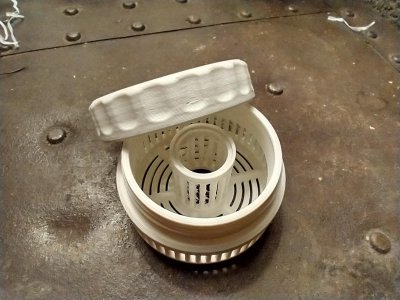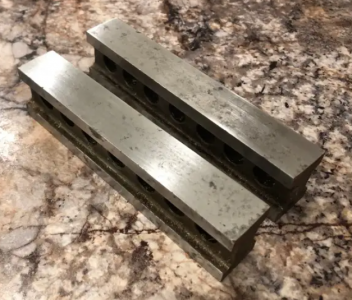Well let's resurrect this thread...
Why? I could just say "why not" but I'll provide a better argument and one related to my career in part as a designer of healthy indoor environments, and a building scientist. Oh and because I am about to buy a nice mildly pair of rusty parallels.. see below.
As much as possible we want to control temperature, the humidity and thereby control the dew point to prevent condensation. When we can't control the temperature and humidity as much as we'd like we want to minimize and control water vapor. So prevent vapour entry, and lock water vapour into a hard to escape matrix so that the dew point within our box, can't be reached.
Best practices:
Make wood box with tight fitting matched 2 deg taper lids
use real wool felt liner
use only pH neutral PVA adhesive
seal and finish the box exterior with vapour resistant finish
leave the wood box interior bare of any finish
Bonus safety precautions will be list near the end of this post. Haha a youtube type teaser to make you read to the end.
Why?
Wool both repels and adsorbs moisture. Wool will repel "bulk" moisture, aka droplets, mist, rain etc but it will adsorb water vapour and lock it into the protein matrix of the hair shafts until equilibrium is reached or until the storage capacity of the fibers is reached. Only real wool is going to provide this benefit, not your cheap synthetics purchased off of amazon. This is why wool thickness matters. The more material the more ability to absorb water vapour.
Wood too acts to absorb and retain moisture to establish equilibrium within the closed environment. Softwood has more open cellular structure and can retain more moisture than hardwood. The sealed box exterior becomes the prison walls, and the bare interior becomes the doorway to allow moisture access to the entire volume of wood. The entire volume of the wood becomes a large prison that impounds water vapour.
Wood and wool are basically acting in the same manner in which desiccants materials work. This is a good thing, BUT can also be a bad thing. A cigar humidor uses the same principles to keep cigars moist. Humidors are "charged" with bulk moisture to saturate the matrix, which then releases vapour slowly based on temperature, humidity and vapour pressure.
SO, we need to keep and handle our boxes so that they always remain in a depleted state, wanting to absorb tons of moisture.
Never leave the box open, especially in humid locations. Once you have the tool out of the box close it right away to prevent moist air from entering and adding unwanted moisture to the wood and wool matrices. When you're done using the tool put it back into the box and seal it tight. Preferably move box to controlled environment with heating and air conditioning. If you're able and have loads of instruments and high end tooling build a tool cabinet and put a small dehumidifier in the cabinet. Make sure the dehumidifier drains to the outside of the closet.
GLUE:
If you must glue use a book binder's PVA adhesive that is pH neutral. These adhesives are buffered to assure that no acid can leach out and harm adjacent materials. As an artist I use Lineco brand because I know it's the best and will never harm my artwork, so it wont harm my steel. I always have it on hand too.
I take too more precautions with my really fine stuff, because it's in an unconditioned garage. I wipe my items down with WD40 corrosion inhibitor. I hate oil saturated wool felt and overly oily instruments. The oil inhibits the desiccant properties of the wool, and it's damn messy. the corrosion inhibitor is far cleaner method.
Then I use desiccants. I used to use large pouches but now I use beads in 3D printed puck like containers. I found the part of thingieverse.

If it cant rust it goes in a box. If it doesn't matter it goes in the drawer of a metal tool chest where it is at the mercy of the environment.
Okay, I'm going to buy these parallels to practise precision grinding.

They don't look like they were that good to begin with, but they're about 1.5" x 1" x 6" which is a nice size for me to practice grinding on my surface grinder before I tackle anything too important. Oh and I can buy these cheap, and get them mailed to me cheaply too.
Now when I'm done I'll try to have the most accurate beautiful parallels around. I'll want to protect them like I protect other fine instruments. In a case. That case will be kept indoors in a controlled environment where the humidity level shall never be high enough to objects to be at the dew point.
As a back up I shall be using the belt and suspenders approach with all the methods I listed above... because I know my brother will take these tools out to the attached garage where the environment is less controlled. It can be humid in the summer and cold in the winter. It is "semi-heated" meaning when occupied the electric space heater is going, but generally all chunks of metal will be only slightly above ambient outdoor air temperature. I will not worry about them at all. He knows how to keep boxes closed and to return instruments to their place when done using them



